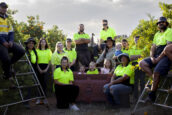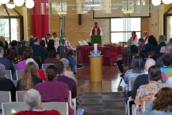
The Digital Reformation

This 31 October marks the 500th anniversary of the Protestant Reformation, which began when Martin Luther nailed his famous 95 theses on the Castle Church door in Wittenberg, Germany.
As part of my observance of this milestone, I am reading Andrew Pettegree’s excellent book, Brand Luther: How an Unheralded Monk Turned his Small Town into a Center of Publishing—Made Himself the Most Famous Man in Europe—and Started the Protestant Reformation.
It recounts the early days of the Reformation through the lens of how Martin Luther and others used new printing technologies, particularly the printing press, to invent a unique publishing style. This helped them spread their message and agenda of reform. The book is about how ministry leaders leverage and adapt technologies to share the Gospel.
But it was never a given that new printing technologies would spread reform across, Germany, and beyond, 500 years ago.
Pettegree writes that at the Reformation’s beginning: “It was 60 years since Johannes Gutenberg had announced, to general applause, the success of his experiments printing with moveable type, but the long-term consequences of this technological development were still decidedly uncertain… It was by no means clear how or why printing could serve a great movement of change.”
It reminds me the conversations I’ve had with people who question the efficacy of the digital social media technologies. “How could such seemingly time-wasting technology, these bits and bytes, be the vehicle for sharing something so substantial as the Gospel, fostering real Christian community, and making disciples?”
In fact, these things are happening all over the internet. But, just as it was for Luther and his fellow reformers, the path there is not a straight line. It is a matter of trial and error, gathering a team of collaborators, and adjusting how we communicate.
For example, when Luther began writing, there was only one not-so-good printer in Wittenberg. He had to recruit a new and better printer. Only once they began to experience success did others flock to the small city. Luther assembled a team to design books and pamphlets that would be eye-catching and encourage people to read them. For this, he relied on the famous painter and friend, Lucas Cranach. Finally, what was most revolutionary about the “brand” they created together was Luther’s unique writing style, which was much clearer, more direct, and written for a more general audience than they religious books of his time.
These same approaches are essential when it comes to using social media in ministry today:
Gather Collaborators
Bring people of different gifts and interests together work on your digital projects. You need a range of people from techies that know the details of how things work, people with artistic and design sensibilities, and people that can help generate content, whether its text, images, podcasts, or videos.
Write for Your Audience
This can be a challenge. Like those in Luther’s time, we in the church are accustomed to writing for an internal church audience. We need to become better at working for a broader audience and writing directly, with power and verve, to engage people online, who are already saturated with information.
Experiment and Experiment Some More
The Reformation was not an overnight success. It was a series of trial and errors and it took time for Luther and his collaborators to find their way, hone their message, and fully realize their “brand.” Be willing to try new things and see what works and what doesn’t. I recently heard a small business owner and non-profit founder say, “If you’re not failing, you’re not trying hard enough.”
However, its important to note that one of the things that distinguishes the print technology of the Reformation from today’s digital technologies (in what Elizabeth Drescher has called the “digital reformation”). Today’s technologies not only enable us to broadcast our ideas and messages but also, and more importantly, to listen and respond to what others are sharing.
As Drescher writes that the “Digital Reformation is driven…by the digitally enhanced spiritual practices of ordinary believers with global access to each other and to all manner of religious knowledged previously available to clergy, scholars, and other religious specialists. This pretty much puts everything into play—our traditions, our histories, our understanding of the sacred.”
There is much to celebrate on this remarkable Reformation milestone and much inspiration to draw for our own time and the challenges before us. Let’s not approach this moment as simply a historical curiosity but as an opportunity to recommit ourselves to sharing the Gospel in our time with these new digital tools—to be always reforming.
Pastor Keith Anderson employs a wide range of social media to minister online and offline.




























































